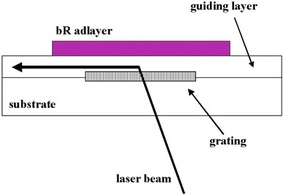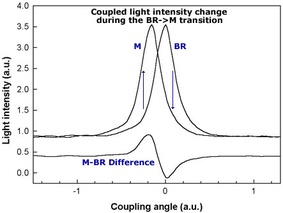|
|
|
|
|
|
 | |
Protein based all-optical switching |
Principal Investigator: András Dér and Pál Ormos
This project is part of the NATO Science for Peace Project 974262
According to our pioneering study, a dry film containing native bacteriorhodopsin shows unique nonlinear optical
properties (refractive index change, controllable by light of different colors, greater than 2x10-3) that are in
many respects superior to those of the materials presently applied in integrated optics.
We studied the static and dynamic response of optical waveguides coated with a thin film of bR.
The size and kinetics of the light-induced refractive index changes of the adlayer were determined under different
conditions of illumination. The results demonstrate the applicability of this protein as an active,
programmable nonlinear optical material in all-optical integrated circuits.
On top of a glass substrate a thin layer (~200 nm) of a material of very high (~2) index of refraction is acting as
an optical waveguide. Light is coupled into the waveguide by a diffraction grating formed at the interface of the
waveguide layer:

The geometrical conditions for effective coupling are very strict: only light coming at a well defined angle
is coupled into the waveguide. The angle depends on the refractive index of the material around the grating.
This phenomenon is the basis of the applications of NLO materials: by changing the refractive index the coupling
(in and out) can be modulated. Thus, optical switching can be established.

In the case of a bR adlayer, the refractive index changes are associated with intermediate transitions during the
photocycle. The figure above shows the coupled intensity change corresponding to the transition from the BR
groundstate to the M intermediate:
Modulataion of light transfer in the waveguide by bR offers the possibility to build an optically controlled
light switch. The animation below shows the concept:

References:
P. Ormos et al., Appl. Phys. Lett. 80, 4060 (2002) View PDF
http://www.nature.com/materials/news/news/020530/portal/m020530-2.html
| |



